Unit 8 Is there a post office near here Section A (1a-2d)课件(共63张PPT)+内嵌音频
文档属性
| 名称 | Unit 8 Is there a post office near here Section A (1a-2d)课件(共63张PPT)+内嵌音频 | 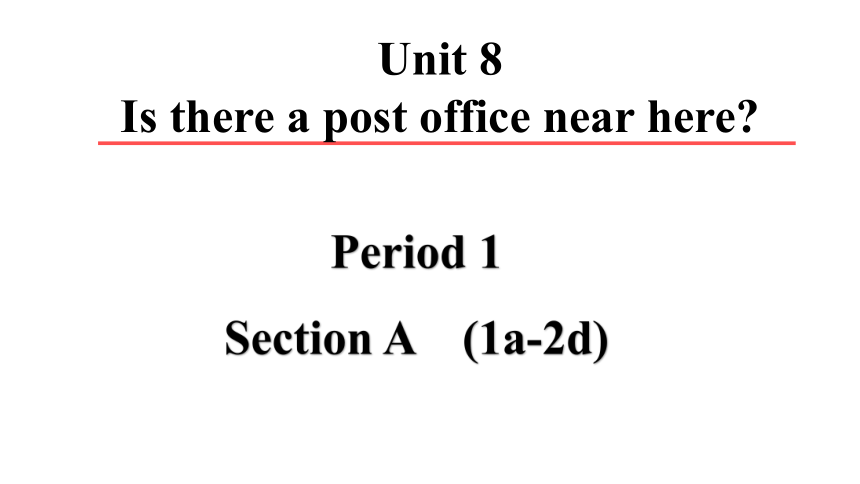 | |
| 格式 | pptx | ||
| 文件大小 | 18.7MB | ||
| 资源类型 | 教案 | ||
| 版本资源 | 人教新目标(Go for it)版 | ||
| 科目 | 英语 | ||
| 更新时间 | 2023-12-16 07:21:43 | ||
图片预览

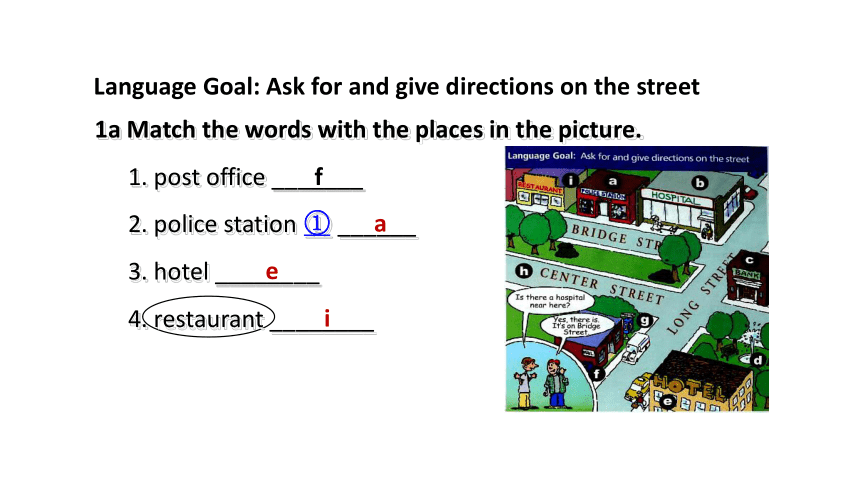
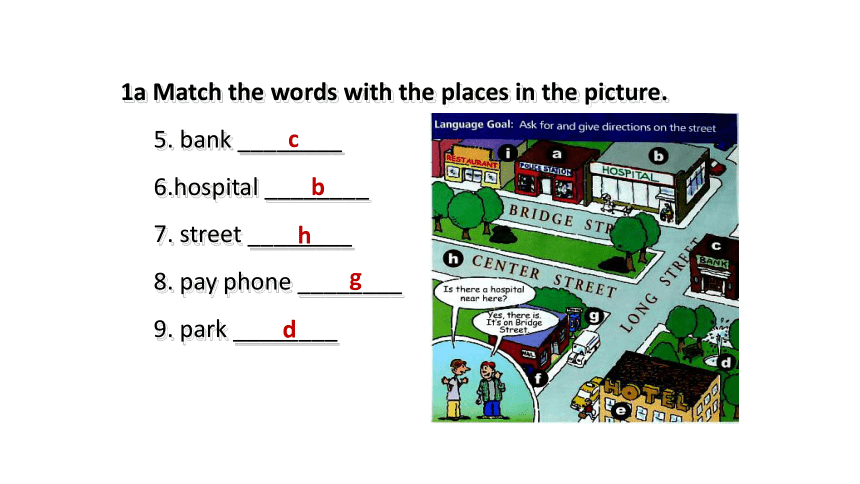
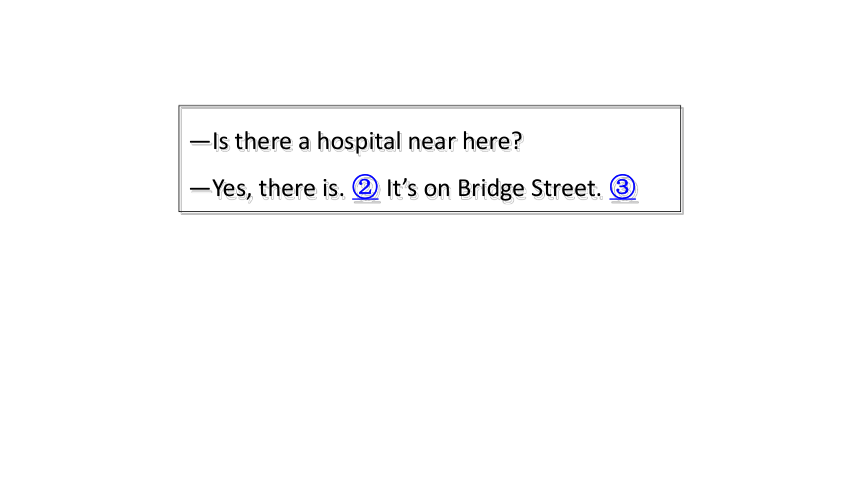
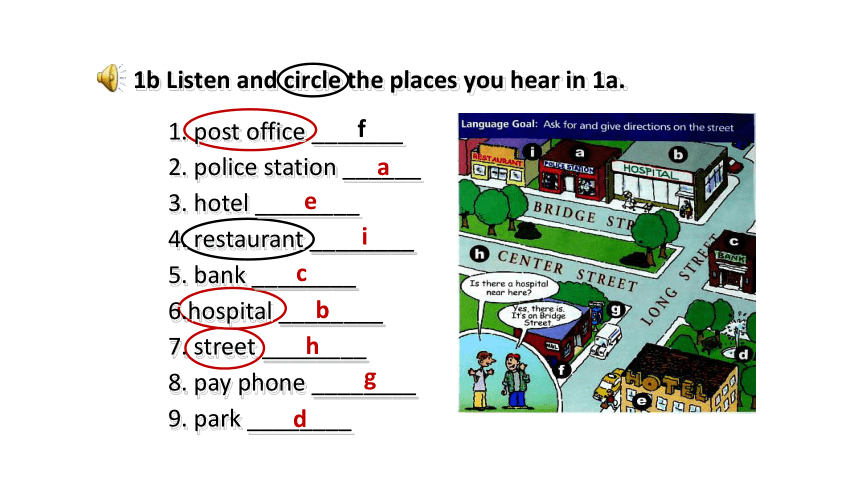
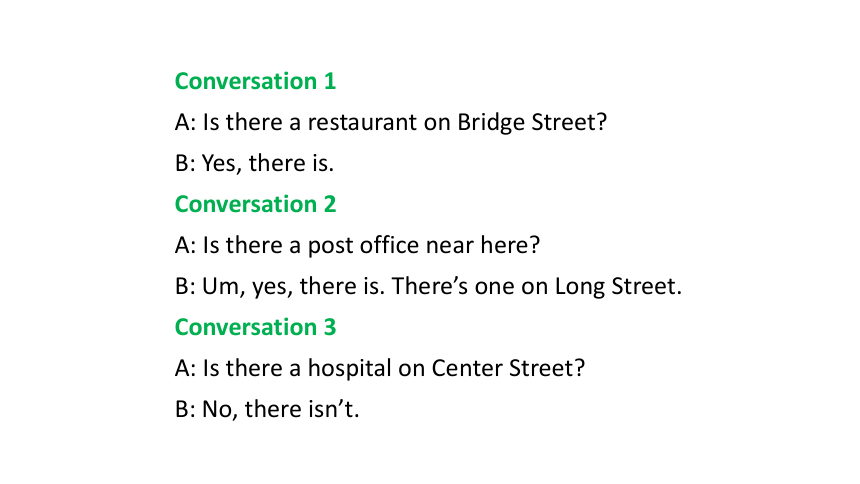

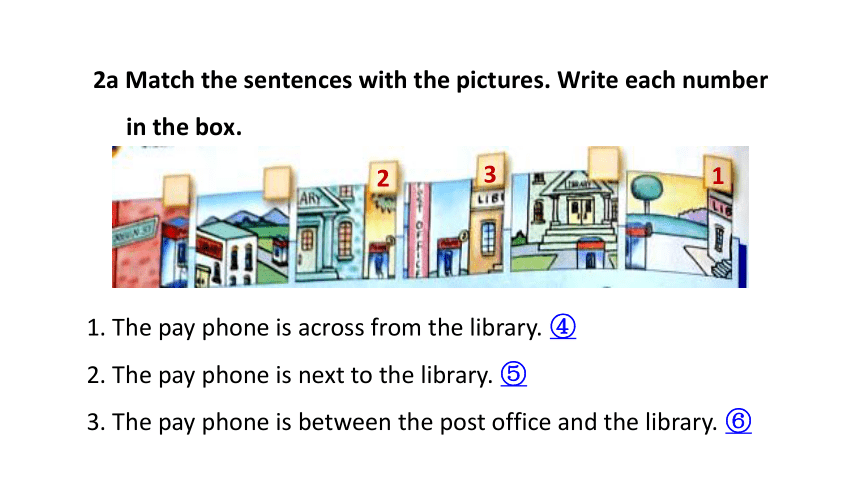
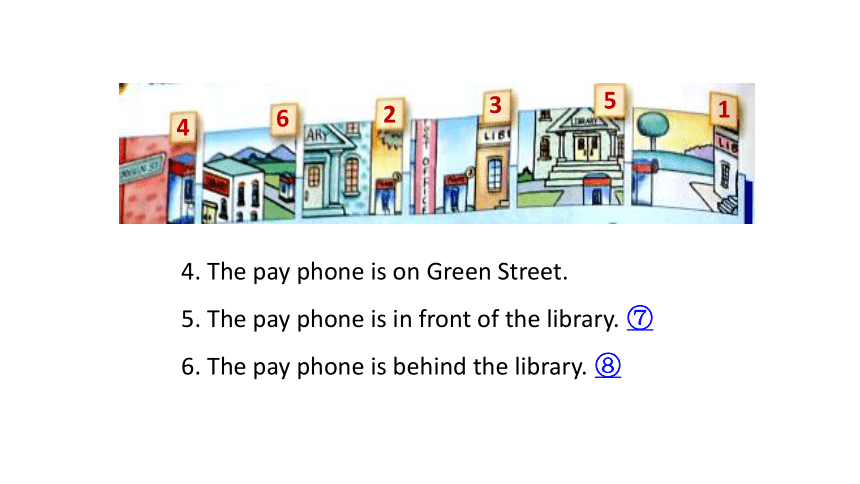
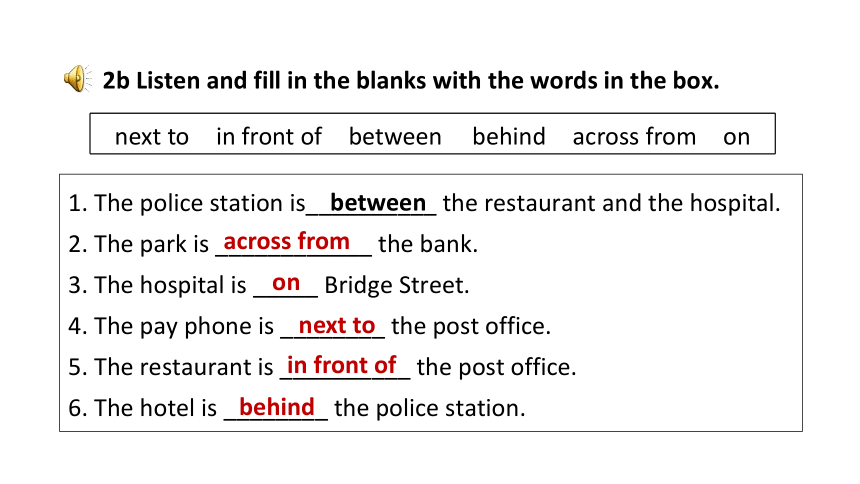
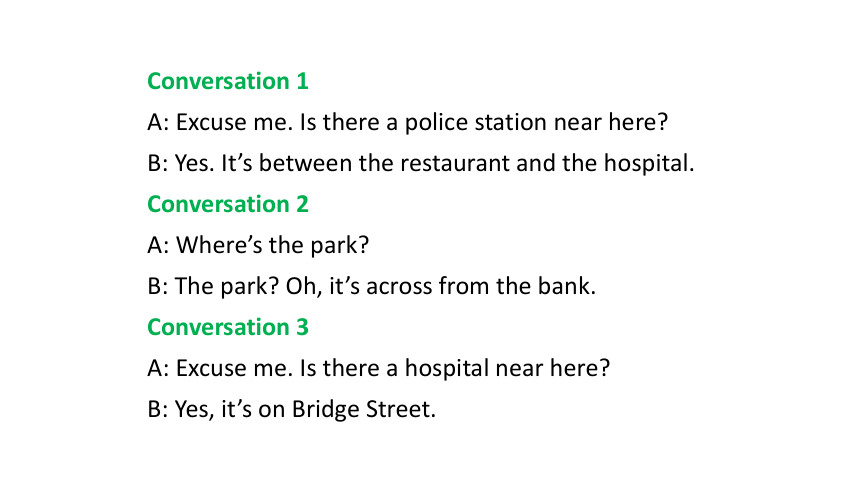

文档简介
(共63张PPT)
Period 1
Section A (1a-2d)
Unit 8
Is there a post office near here
Language Goal: Ask for and give directions on the street
1a Match the words with the places in the picture.
1. post office _______
2. police station ① ______
3. hotel ________
4. restaurant ________
e
a
f
i
1a Match the words with the places in the picture.
5. bank ________
6.hospital ________
7. street ________
8. pay phone ________
9. park ________
g
d
b
c
h
—Is there a hospital near here
—Yes, there is. ② It’s on Bridge Street. ③
1b Listen and circle the places you hear in 1a.
1. post office _______
2. police station ______
3. hotel ________
4. restaurant ________
5. bank ________
6.hospital ________
7. street ________
8. pay phone ________
9. park ________
f
e
g
d
b
c
a
i
h
Conversation 1
A: Is there a restaurant on Bridge Street
B: Yes, there is.
Conversation 2
A: Is there a post office near here
B: Um, yes, there is. There’s one on Long Street.
Conversation 3
A: Is there a hospital on Center Street
B: No, there isn’t.
1c Practice the conversation with your partner. Then ask and answer questions about the other places in 1a.
A: Is there a hospital near here
B: Yes, there is. It's on Bridge Street.
2a Match the sentences with the pictures. Write each number in the box.
3
2
1
1. The pay phone is across from the library. ④
2. The pay phone is next to the library. ⑤
3. The pay phone is between the post office and the library. ⑥
6
5
3
4
2
1
4. The pay phone is on Green Street.
5. The pay phone is in front of the library. ⑦
6. The pay phone is behind the library. ⑧
2b Listen and fill in the blanks with the words in the box.
1. The police station is__________ the restaurant and the hospital.
2. The park is ____________ the bank.
3. The hospital is _____ Bridge Street.
4. The pay phone is ________ the post office.
5. The restaurant is __________ the post office.
6. The hotel is ________ the police station.
across from
next to
behind
on
in front of
next to in front of between behind across from on
between
Conversation 1
A: Excuse me. Is there a police station near here
B: Yes. It’s between the restaurant and the hospital.
Conversation 2
A: Where’s the park
B: The park Oh, it’s across from the bank.
Conversation 3
A: Excuse me. Is there a hospital near here
B: Yes, it’s on Bridge Street.
Conversation 4
A: Where’s the pay phone
B: It’s next to the post office.
Conversation 5
A: Excuse me. Are there any restaurants near here
B: Yes, there’s one in front of the post office.
Conversation 6
A: Where’s the hotel
B: The hotel It’s behind the police station.
2c Ask and answer questions about the places in 1a on page 43.
—Where's the hospital
—It's next to the police station.
Tony: Hi, excuse me. ⑨
Linda: Yes. How can I help you ⑩
Tony: Well, I'm new in town. Is there a bank around here
Linda: Yes, there is. It's on Center Street. It's across from the park.
Tony: Oh...where's Center Street
Linda: It's not too far from here. I can walk with you.
Tony: Oh, that's great! Thanks so much.
Linda: No problem.
2d Role-play the conversation.
问路时要使用礼貌用语。
面对他人的求助我们要热情回应,真诚提供帮助。
①police station
police /p 'li s/ n. 警察
police 是集体名词, 是“警察”的总称, 即指“警察部门”或“多个警察”,前面经常加the。作“警察”讲时相当于policewomen and policemen, 谓语动词用复数形式。
考点1
考向
特别提醒:表示“一名警察”时不能用a police, 应该用a policeman(一名男警察)/a policewoman(一名女警察)。
e.g. The police are searching for a man with a beard.
警察正在搜寻一个留胡子的人。
What is your dream job, a pilot or a policeman
你梦想的工作是什么,是飞行员还是警察?
小贴士: 与police 用法类似的词有people。这类词表示单数概念时, 要改用别的词汇。如:people → a person。
考题1: 警察正在帮助这些孩子。
__________ ___________ __________ helping the children.
The police are
返回
②—Is there a hospital near here —Yes, there is.
Is/Are there... 有……吗?
此句型用于问路。肯定回答“Yes, there is.”;否定回答“No, there isn’t.”。
e.g. —Is there a bookstore near here
这附近有书店吗?
—No, there isn’t.
不,没有。
考点2
考向
特别提醒:
there 和be 连用,不和have/has 连用。
e.g. 今天将有一场比赛。
There will be a match today.( √ )
There will have a match today.( x )
辨析: there be 与have/has
there be 表示“某处有某物/人”, 指客观存在。句型为“There be+某物/人+某地.”。句中有两个或多个并列主语时, be动词的形式要与最靠近的主语在数上保持一致, 即遵循“就近原则”。
have/has 表示“某人/物有”, 指从属关系。句型为“某人/物+have/has+ 某物.”。用have 或has 取决于句子的主语。
e.g. There is a pen and two pencils in my pencil box.
在我的铅笔盒里有一支钢笔和两支铅笔。(钢笔和铅笔
不一定是属于我的)
There are two pencils and a pen in my pencil box.
在我的铅笔盒里有两支铅笔和一支钢笔。
I have a pen and two pencils.
我有一支钢笔和两支铅笔。(钢笔和铅笔是属于我的)
He has a car. 他有一辆汽车。
考题2: 桌子上有一支钢笔和一些书。(be)
___________________ and some books on the desk.
There is a pen
辨析: in hospital 与in the hospital
in hospital 指“生病住院”, hospital 是一个抽象名词。
in the hospital 指“在医院”, 可能是到医院工作, 可能是看护病人。由于有了定冠词the的限制, hospital成了一个具体指某个地点的名词。
e.g. His mother is in hospital. 他妈妈住院了。
There are many people in the hospital. 医院里有很多人。
hospital /'h sp tl/ , /'hɑ sp tl/n. 医院
考点3
near/n , n r/ prep. 在……附近
介词,在……附近,相当于close to。
e.g. You will also find small shops near the train station.
你还会在火车站附近找到小商店。
The bank is near/close to the zoo.
银行在动物园附近。
考点4
考向
拓展:near 的常见用法:
near 形容词,“近的”,反义词是far“远的”。
e.g. The hotel is very near. 这家旅馆非常近。
副词,“在附近”。
e.g. Come near and enjoy the picture.
靠近点,欣赏一下这幅画。
考题3: [济宁] —Is your home n our school
—No, it’s far away.
返回
ear
③It’s on Bridge Street.
on Bridge Street 在大桥街上
e.g. She lives on Center Street.
她住在中心大街上。
考点5
专有名词,首字母大写
表示“在街上”,英式英语用“in the street”, 美式英语用“on the street”。如果接门牌号,则都用at。
拓展: 街道名称与介词的连用
“on+街道名称” 在……街/ 路上 My house is on Nanjing Road.
我家在南京路上。
“at+门牌号+街 道名称”在……街/ 路……号 Mr Green lives at No. 66 Center Street.
格林先生住在中心大街66 号。
考题4: I often go to the bookstore _______ Quancheng Road although it’s crowded(拥挤的).
A. on B. for C. with D. between
返回
【点拨】用固定搭配法。“on/in + 街道名称”表示“ 在…… 街或路上”。
A
④The pay phone is across from the library.
pay phone 付费电话
e.g. They looked for a pay phone.
他们在找一个付费电话。
考点6
拓展:pay 的其他用法:
含义 用法 示例
n. 工资, 薪水 表示“薪水不错/ 低”用good/low Do you get good pay
你的工资高吗?
v. 付费 pay sb. 付钱给某人 The boss pays the workers every month.
老板每月都给工人发薪水。
pay for sth. 为某物付钱 You may either bring a lunch box or pay for lunch at our restaurants. 你可以带一个午餐盒,也可以在我们餐厅买午餐。
pay...for sth. 买某物付……钱 You need to pay 8, 000 yuan for the computer.
你需要付八千元买这台电脑。
考题5: [绥化] — Excuse me, is this coat yours
—Yes. I ________ 300 yuan ________ it.
A. payed; in B. paid; for C. paid; on
【点拨】pay money for sth.“为某物付多少钱”。
B
(高频) across from 在……对面
across from 是固定短语, 其后接表示地点的名词或代词,意为“在……对面”。
e.g. The pay phone is across from the bank.
付费电话在银行的对面。
He sat across from me and waited to see the result.
他坐在我的对面,等着看结果。
He lives in the house across from/opposite/on the other side of ours. 他住在我们对面的那个房子里。
考点7
across from =opposite = on the other side of...在……的对面
考向
考题6: 书店在超市的对面。
The bookstore is ________ ________ the supermarket.
across from
across / 'kr s, 'kr s/ adv.& prep. 过;穿过
across 既作副词也作介词,常与walk、go、swim 等词连用。
e.g. Can you swim across 你能游过去吗?
I can swim across the river in 10 minutes.
我可以在十分钟之内游过这条河。
考点8
考向
辨析: across, over 与through
across 指从物体表面横向穿过, 由一边到另一边。
over 多指从物体上方翻越或跨越。
through 强调从物体内部或空间穿过。
一语辨异:When we walk through the park, we see a car going across the bridge and a plane flying over our head.当我们步行穿过公园时,我们看到一辆汽车从桥上经过、一架飞机从我们头顶上方飞过。
拓展:cross 作动词,意为“横过;穿过”,相当于go/walk across。
e.g. Don’t cross ( = go across) the road when the traffic lights are red. 当交通灯是红色时,不要横过马路。
考题7: [无锡] A new bridge was built _______ the Yellow River last year.
A. around B. across
C. against D. along
【点拨】around 围绕;across 横穿;against 紧靠;along 沿着。根据常识可知桥应该是横跨黄河。
B
返回
考题8: [遂宁] Look! The traffic light is green. We can go ________ the road now.
A. across B. above
C. below D. against
A
⑤The pay phone is next to the library.
next to 在……近旁, 紧邻
e.g. The notebook is next to the pencil case.
笔记本在铅笔盒的旁边。
考点9
方位介词短语,表空间位置,与beside 同义
辨析: next to 与near
next to next to有“紧挨着”之意, next to比near靠得更近。 Peter sits next to Mike.
彼得紧挨着迈克坐。
near 从空间讲near 只表示 “在……附近”。 Peter sits near Tom.
彼得坐在汤姆附近。
考题9: 他旁边的那位女士是我的姑姑莉兹。
The woman _________ ________ him is my aunt Liz.
next to
返回
⑥The pay phone is between the post office and the library.
between...and... 在……和……之间
考点10
between...and...连接两个并列成分,可以表示地点的概念和时间的概念。
只限于两者之间。
e.g. There is no parking here between 9 a. m. and 6 p. m.
上午9 时至下午6 时此处禁止停车。
The pay phone is between the bank and the hotel.
付费电话在银行和旅馆之间。
You sit between him and me.
你坐在我和他之间。
后接人称代词时用其宾格形式
考题10: 约翰尽力在工作和娱乐中获得平衡。
John does his best to keep the balance __________ work ________ play.
返回
between
and
⑦The pay phone is in front of the library.
front/fr nt/ n. 前面
e.g. Lucy, come to the front of the classroom, please.
露西, 请到教室前面来。
考点11
反义词back“后面”
……的前面
联想记忆:
in front of 反义词 behind
in the front of 反义词 at the back of
辨析: in front of 与in the front of
in front of 强调一个物体在另一个物体外部的前面 The dog is in front of the bus.那只狗在公共汽车的前面。
in the front of 强调一个物体在另一 个物体内部的前面 The driver is in the front of the bus.
司机在公共汽车的前部。
考题11: —Why are you standing, Alice
—I can’t see the blackboard clearly. Two tall boys are sitting _______ me.
A. behind B. next to C. between D. in front of
【点拨】用逻辑推理法。看不清黑板的原因是两个高个子男生坐在“我”的前面,故可知答案。
D
返回
⑧The pay phone is behind the library.
behind /b ha nd/ prep. 在……的后面
e.g. There is a cat behind the door.
门后面有一只猫。
His family are right behind him.
他的家人完全支持他。
考点12
介词,表示“支持”
辨析: behind 与after
behind 常用于表示位置或方向上的“在……的后面” They may be in front of a big rock or behind a tree. 它们可能在一块大岩石的前面或一棵树的后面。
after 常用于表示时间上的 “在……之后”。 Let’s watch a film after dinner.
晚饭后我们看一场电影吧。
一语辨异:After an hour, we got to the cafe behind the bookstore.一个小时之后,我们到达了书店后面的咖啡馆。
考题12: Anna is taller than me. She sits ______ me in the classroom.
A. between B. from
C. behind D. among
C
返回
⑨Hi, excuse me.
excuse me 劳驾;打扰一下
用于向陌生人求助,其中excuse 作动词,意为“原谅,宽恕”。
e.g. Excuse me. Is there a hospital near here
打扰一下。这儿附近有医院吗?
考点13
考向
温馨提示:
回答 “Excuse me...”时,不可以说“I’ll excuse you.”, 而应该说“Never mind./That’s all right.(没关系 。)”或“Certainly.(当然。)”。
拓展:(1) excuse me 还可用于以下场合:
用法 示例
和别人谈话时要出去或做别的事时 Excuse me, just a minute.
对不起,稍等一下。
表示失礼,请求原谅时 Excuse me for troubling you.
抱歉,打扰你们了。
客气地纠正别人的话时 Excuse me, I think you are wrong.
对不起/ 失敬了,我认为你错了。
客气地请求许可时 Excuse me, but can I go out for a while
对不起,我能出去一会儿吗?
(2) Sorry. ( = I’m sorry.) 意为“抱歉;对不起”。通常用于表示由于某种过失或办不成某事的一种歉意。回答时常用“That’s OK. / That’s all right. / It doesn’t matter.”等。
e.g. — I’m sorry I’m late. 对不起,我迟到了。
—That’s OK. 没关系。
(3)excuse 也可作名词,意为“借口,理由”。
e.g. Late again! What’s your excuse this time
又迟到了!你这次有什么借口?
It gives me an excuse to take the car. 这使我有理由开车去。
考题13: —_______, could you tell me when the movie will start
—At 7 o’clock in the evening.
A. Thank you B. Don’t worry
C. Excuse me D. All right
【点拨】由后面“你能告诉我电影什么时候开始吗”可知是向别人求助,此处应用“打扰;劳驾”。
返回
C
⑩How can I help you
How can I help you 我怎么帮你呢?
交际用语。本句是向别人提供帮助时的常用语。回答时不需要用yes 或no, 直接说明需要帮忙的事即可。
考点14
考向
“向别人提供帮助”的其他表达法:
May/ Can I help you
What can I do for you
Let me help you. (=Let me give you a hand.)
Would you like me to help you
e.g. —How can I help you
我怎么帮你呢?
—I’d like to send this letter to my brother.
我想把这封信寄给我哥哥。
—What can I do for you
我可以为你做什么吗?
—I’m looking for a book named Jane Eyre.
我正在找一本叫《简·爱》的书。
返回
Is there a bank around here
around/ ra nd/ prep. 在……周围
e.g. They are sitting around the fire.
他们正围火而坐。
I hope I can travel around the world one day.
我希望有一天我能环游世界。
考点15
around the world,意为“全世界”,相当于
across the world 或all over the world。
到处,各处
拓展: around 还可用作副词, 用法如下:
副词 around “围绕”, 常用于动词后, 作状语。 They make the wheels go around.
他们使这些轮子转动起来。
“大约”, 用于数字前, 相当于about。 He usually reads China Daily
around/about 6: 00 a.m. 他通常在早晨大约6点钟看《中国日报》
返回
It’s not too far from here.
far from 远离
e.g. My home is not far(away) from our school.
我的家离我们学校不远。
The station is two kilometers(away) from here.
车站离这儿有两千米远。
考点16
不与具体数字连用。
far from 相当于far away from, 通常不与具体数字连用,若出现具体数字,常用away from。
返回
考题14: [天津]让我们一起去看湖景。它离这儿并不远。
Let’s go to see the lake. It’s not _______ _________here.
far from
本节课主要练习了听力, 学习了询问和指示方向的句型, 掌握了知识点Is there… , pay, across from, next to, between…and…, front的用法, 学会了谈论场所位置。
Period 1
Section A (1a-2d)
Unit 8
Is there a post office near here
Language Goal: Ask for and give directions on the street
1a Match the words with the places in the picture.
1. post office _______
2. police station ① ______
3. hotel ________
4. restaurant ________
e
a
f
i
1a Match the words with the places in the picture.
5. bank ________
6.hospital ________
7. street ________
8. pay phone ________
9. park ________
g
d
b
c
h
—Is there a hospital near here
—Yes, there is. ② It’s on Bridge Street. ③
1b Listen and circle the places you hear in 1a.
1. post office _______
2. police station ______
3. hotel ________
4. restaurant ________
5. bank ________
6.hospital ________
7. street ________
8. pay phone ________
9. park ________
f
e
g
d
b
c
a
i
h
Conversation 1
A: Is there a restaurant on Bridge Street
B: Yes, there is.
Conversation 2
A: Is there a post office near here
B: Um, yes, there is. There’s one on Long Street.
Conversation 3
A: Is there a hospital on Center Street
B: No, there isn’t.
1c Practice the conversation with your partner. Then ask and answer questions about the other places in 1a.
A: Is there a hospital near here
B: Yes, there is. It's on Bridge Street.
2a Match the sentences with the pictures. Write each number in the box.
3
2
1
1. The pay phone is across from the library. ④
2. The pay phone is next to the library. ⑤
3. The pay phone is between the post office and the library. ⑥
6
5
3
4
2
1
4. The pay phone is on Green Street.
5. The pay phone is in front of the library. ⑦
6. The pay phone is behind the library. ⑧
2b Listen and fill in the blanks with the words in the box.
1. The police station is__________ the restaurant and the hospital.
2. The park is ____________ the bank.
3. The hospital is _____ Bridge Street.
4. The pay phone is ________ the post office.
5. The restaurant is __________ the post office.
6. The hotel is ________ the police station.
across from
next to
behind
on
in front of
next to in front of between behind across from on
between
Conversation 1
A: Excuse me. Is there a police station near here
B: Yes. It’s between the restaurant and the hospital.
Conversation 2
A: Where’s the park
B: The park Oh, it’s across from the bank.
Conversation 3
A: Excuse me. Is there a hospital near here
B: Yes, it’s on Bridge Street.
Conversation 4
A: Where’s the pay phone
B: It’s next to the post office.
Conversation 5
A: Excuse me. Are there any restaurants near here
B: Yes, there’s one in front of the post office.
Conversation 6
A: Where’s the hotel
B: The hotel It’s behind the police station.
2c Ask and answer questions about the places in 1a on page 43.
—Where's the hospital
—It's next to the police station.
Tony: Hi, excuse me. ⑨
Linda: Yes. How can I help you ⑩
Tony: Well, I'm new in town. Is there a bank around here
Linda: Yes, there is. It's on Center Street. It's across from the park.
Tony: Oh...where's Center Street
Linda: It's not too far from here. I can walk with you.
Tony: Oh, that's great! Thanks so much.
Linda: No problem.
2d Role-play the conversation.
问路时要使用礼貌用语。
面对他人的求助我们要热情回应,真诚提供帮助。
①police station
police /p 'li s/ n. 警察
police 是集体名词, 是“警察”的总称, 即指“警察部门”或“多个警察”,前面经常加the。作“警察”讲时相当于policewomen and policemen, 谓语动词用复数形式。
考点1
考向
特别提醒:表示“一名警察”时不能用a police, 应该用a policeman(一名男警察)/a policewoman(一名女警察)。
e.g. The police are searching for a man with a beard.
警察正在搜寻一个留胡子的人。
What is your dream job, a pilot or a policeman
你梦想的工作是什么,是飞行员还是警察?
小贴士: 与police 用法类似的词有people。这类词表示单数概念时, 要改用别的词汇。如:people → a person。
考题1: 警察正在帮助这些孩子。
__________ ___________ __________ helping the children.
The police are
返回
②—Is there a hospital near here —Yes, there is.
Is/Are there... 有……吗?
此句型用于问路。肯定回答“Yes, there is.”;否定回答“No, there isn’t.”。
e.g. —Is there a bookstore near here
这附近有书店吗?
—No, there isn’t.
不,没有。
考点2
考向
特别提醒:
there 和be 连用,不和have/has 连用。
e.g. 今天将有一场比赛。
There will be a match today.( √ )
There will have a match today.( x )
辨析: there be 与have/has
there be 表示“某处有某物/人”, 指客观存在。句型为“There be+某物/人+某地.”。句中有两个或多个并列主语时, be动词的形式要与最靠近的主语在数上保持一致, 即遵循“就近原则”。
have/has 表示“某人/物有”, 指从属关系。句型为“某人/物+have/has+ 某物.”。用have 或has 取决于句子的主语。
e.g. There is a pen and two pencils in my pencil box.
在我的铅笔盒里有一支钢笔和两支铅笔。(钢笔和铅笔
不一定是属于我的)
There are two pencils and a pen in my pencil box.
在我的铅笔盒里有两支铅笔和一支钢笔。
I have a pen and two pencils.
我有一支钢笔和两支铅笔。(钢笔和铅笔是属于我的)
He has a car. 他有一辆汽车。
考题2: 桌子上有一支钢笔和一些书。(be)
___________________ and some books on the desk.
There is a pen
辨析: in hospital 与in the hospital
in hospital 指“生病住院”, hospital 是一个抽象名词。
in the hospital 指“在医院”, 可能是到医院工作, 可能是看护病人。由于有了定冠词the的限制, hospital成了一个具体指某个地点的名词。
e.g. His mother is in hospital. 他妈妈住院了。
There are many people in the hospital. 医院里有很多人。
hospital /'h sp tl/ , /'hɑ sp tl/n. 医院
考点3
near/n , n r/ prep. 在……附近
介词,在……附近,相当于close to。
e.g. You will also find small shops near the train station.
你还会在火车站附近找到小商店。
The bank is near/close to the zoo.
银行在动物园附近。
考点4
考向
拓展:near 的常见用法:
near 形容词,“近的”,反义词是far“远的”。
e.g. The hotel is very near. 这家旅馆非常近。
副词,“在附近”。
e.g. Come near and enjoy the picture.
靠近点,欣赏一下这幅画。
考题3: [济宁] —Is your home n our school
—No, it’s far away.
返回
ear
③It’s on Bridge Street.
on Bridge Street 在大桥街上
e.g. She lives on Center Street.
她住在中心大街上。
考点5
专有名词,首字母大写
表示“在街上”,英式英语用“in the street”, 美式英语用“on the street”。如果接门牌号,则都用at。
拓展: 街道名称与介词的连用
“on+街道名称” 在……街/ 路上 My house is on Nanjing Road.
我家在南京路上。
“at+门牌号+街 道名称”在……街/ 路……号 Mr Green lives at No. 66 Center Street.
格林先生住在中心大街66 号。
考题4: I often go to the bookstore _______ Quancheng Road although it’s crowded(拥挤的).
A. on B. for C. with D. between
返回
【点拨】用固定搭配法。“on/in + 街道名称”表示“ 在…… 街或路上”。
A
④The pay phone is across from the library.
pay phone 付费电话
e.g. They looked for a pay phone.
他们在找一个付费电话。
考点6
拓展:pay 的其他用法:
含义 用法 示例
n. 工资, 薪水 表示“薪水不错/ 低”用good/low Do you get good pay
你的工资高吗?
v. 付费 pay sb. 付钱给某人 The boss pays the workers every month.
老板每月都给工人发薪水。
pay for sth. 为某物付钱 You may either bring a lunch box or pay for lunch at our restaurants. 你可以带一个午餐盒,也可以在我们餐厅买午餐。
pay...for sth. 买某物付……钱 You need to pay 8, 000 yuan for the computer.
你需要付八千元买这台电脑。
考题5: [绥化] — Excuse me, is this coat yours
—Yes. I ________ 300 yuan ________ it.
A. payed; in B. paid; for C. paid; on
【点拨】pay money for sth.“为某物付多少钱”。
B
(高频) across from 在……对面
across from 是固定短语, 其后接表示地点的名词或代词,意为“在……对面”。
e.g. The pay phone is across from the bank.
付费电话在银行的对面。
He sat across from me and waited to see the result.
他坐在我的对面,等着看结果。
He lives in the house across from/opposite/on the other side of ours. 他住在我们对面的那个房子里。
考点7
across from =opposite = on the other side of...在……的对面
考向
考题6: 书店在超市的对面。
The bookstore is ________ ________ the supermarket.
across from
across / 'kr s, 'kr s/ adv.& prep. 过;穿过
across 既作副词也作介词,常与walk、go、swim 等词连用。
e.g. Can you swim across 你能游过去吗?
I can swim across the river in 10 minutes.
我可以在十分钟之内游过这条河。
考点8
考向
辨析: across, over 与through
across 指从物体表面横向穿过, 由一边到另一边。
over 多指从物体上方翻越或跨越。
through 强调从物体内部或空间穿过。
一语辨异:When we walk through the park, we see a car going across the bridge and a plane flying over our head.当我们步行穿过公园时,我们看到一辆汽车从桥上经过、一架飞机从我们头顶上方飞过。
拓展:cross 作动词,意为“横过;穿过”,相当于go/walk across。
e.g. Don’t cross ( = go across) the road when the traffic lights are red. 当交通灯是红色时,不要横过马路。
考题7: [无锡] A new bridge was built _______ the Yellow River last year.
A. around B. across
C. against D. along
【点拨】around 围绕;across 横穿;against 紧靠;along 沿着。根据常识可知桥应该是横跨黄河。
B
返回
考题8: [遂宁] Look! The traffic light is green. We can go ________ the road now.
A. across B. above
C. below D. against
A
⑤The pay phone is next to the library.
next to 在……近旁, 紧邻
e.g. The notebook is next to the pencil case.
笔记本在铅笔盒的旁边。
考点9
方位介词短语,表空间位置,与beside 同义
辨析: next to 与near
next to next to有“紧挨着”之意, next to比near靠得更近。 Peter sits next to Mike.
彼得紧挨着迈克坐。
near 从空间讲near 只表示 “在……附近”。 Peter sits near Tom.
彼得坐在汤姆附近。
考题9: 他旁边的那位女士是我的姑姑莉兹。
The woman _________ ________ him is my aunt Liz.
next to
返回
⑥The pay phone is between the post office and the library.
between...and... 在……和……之间
考点10
between...and...连接两个并列成分,可以表示地点的概念和时间的概念。
只限于两者之间。
e.g. There is no parking here between 9 a. m. and 6 p. m.
上午9 时至下午6 时此处禁止停车。
The pay phone is between the bank and the hotel.
付费电话在银行和旅馆之间。
You sit between him and me.
你坐在我和他之间。
后接人称代词时用其宾格形式
考题10: 约翰尽力在工作和娱乐中获得平衡。
John does his best to keep the balance __________ work ________ play.
返回
between
and
⑦The pay phone is in front of the library.
front/fr nt/ n. 前面
e.g. Lucy, come to the front of the classroom, please.
露西, 请到教室前面来。
考点11
反义词back“后面”
……的前面
联想记忆:
in front of 反义词 behind
in the front of 反义词 at the back of
辨析: in front of 与in the front of
in front of 强调一个物体在另一个物体外部的前面 The dog is in front of the bus.那只狗在公共汽车的前面。
in the front of 强调一个物体在另一 个物体内部的前面 The driver is in the front of the bus.
司机在公共汽车的前部。
考题11: —Why are you standing, Alice
—I can’t see the blackboard clearly. Two tall boys are sitting _______ me.
A. behind B. next to C. between D. in front of
【点拨】用逻辑推理法。看不清黑板的原因是两个高个子男生坐在“我”的前面,故可知答案。
D
返回
⑧The pay phone is behind the library.
behind /b ha nd/ prep. 在……的后面
e.g. There is a cat behind the door.
门后面有一只猫。
His family are right behind him.
他的家人完全支持他。
考点12
介词,表示“支持”
辨析: behind 与after
behind 常用于表示位置或方向上的“在……的后面” They may be in front of a big rock or behind a tree. 它们可能在一块大岩石的前面或一棵树的后面。
after 常用于表示时间上的 “在……之后”。 Let’s watch a film after dinner.
晚饭后我们看一场电影吧。
一语辨异:After an hour, we got to the cafe behind the bookstore.一个小时之后,我们到达了书店后面的咖啡馆。
考题12: Anna is taller than me. She sits ______ me in the classroom.
A. between B. from
C. behind D. among
C
返回
⑨Hi, excuse me.
excuse me 劳驾;打扰一下
用于向陌生人求助,其中excuse 作动词,意为“原谅,宽恕”。
e.g. Excuse me. Is there a hospital near here
打扰一下。这儿附近有医院吗?
考点13
考向
温馨提示:
回答 “Excuse me...”时,不可以说“I’ll excuse you.”, 而应该说“Never mind./That’s all right.(没关系 。)”或“Certainly.(当然。)”。
拓展:(1) excuse me 还可用于以下场合:
用法 示例
和别人谈话时要出去或做别的事时 Excuse me, just a minute.
对不起,稍等一下。
表示失礼,请求原谅时 Excuse me for troubling you.
抱歉,打扰你们了。
客气地纠正别人的话时 Excuse me, I think you are wrong.
对不起/ 失敬了,我认为你错了。
客气地请求许可时 Excuse me, but can I go out for a while
对不起,我能出去一会儿吗?
(2) Sorry. ( = I’m sorry.) 意为“抱歉;对不起”。通常用于表示由于某种过失或办不成某事的一种歉意。回答时常用“That’s OK. / That’s all right. / It doesn’t matter.”等。
e.g. — I’m sorry I’m late. 对不起,我迟到了。
—That’s OK. 没关系。
(3)excuse 也可作名词,意为“借口,理由”。
e.g. Late again! What’s your excuse this time
又迟到了!你这次有什么借口?
It gives me an excuse to take the car. 这使我有理由开车去。
考题13: —_______, could you tell me when the movie will start
—At 7 o’clock in the evening.
A. Thank you B. Don’t worry
C. Excuse me D. All right
【点拨】由后面“你能告诉我电影什么时候开始吗”可知是向别人求助,此处应用“打扰;劳驾”。
返回
C
⑩How can I help you
How can I help you 我怎么帮你呢?
交际用语。本句是向别人提供帮助时的常用语。回答时不需要用yes 或no, 直接说明需要帮忙的事即可。
考点14
考向
“向别人提供帮助”的其他表达法:
May/ Can I help you
What can I do for you
Let me help you. (=Let me give you a hand.)
Would you like me to help you
e.g. —How can I help you
我怎么帮你呢?
—I’d like to send this letter to my brother.
我想把这封信寄给我哥哥。
—What can I do for you
我可以为你做什么吗?
—I’m looking for a book named Jane Eyre.
我正在找一本叫《简·爱》的书。
返回
Is there a bank around here
around/ ra nd/ prep. 在……周围
e.g. They are sitting around the fire.
他们正围火而坐。
I hope I can travel around the world one day.
我希望有一天我能环游世界。
考点15
around the world,意为“全世界”,相当于
across the world 或all over the world。
到处,各处
拓展: around 还可用作副词, 用法如下:
副词 around “围绕”, 常用于动词后, 作状语。 They make the wheels go around.
他们使这些轮子转动起来。
“大约”, 用于数字前, 相当于about。 He usually reads China Daily
around/about 6: 00 a.m. 他通常在早晨大约6点钟看《中国日报》
返回
It’s not too far from here.
far from 远离
e.g. My home is not far(away) from our school.
我的家离我们学校不远。
The station is two kilometers(away) from here.
车站离这儿有两千米远。
考点16
不与具体数字连用。
far from 相当于far away from, 通常不与具体数字连用,若出现具体数字,常用away from。
返回
考题14: [天津]让我们一起去看湖景。它离这儿并不远。
Let’s go to see the lake. It’s not _______ _________here.
far from
本节课主要练习了听力, 学习了询问和指示方向的句型, 掌握了知识点Is there… , pay, across from, next to, between…and…, front的用法, 学会了谈论场所位置。
同课章节目录
- Unit 1 Can you play the guitar?
- Section A
- Section B
- Unit 2 What time do you go to school?
- Section A
- Section B
- Unit 3 How do you get to school?
- Section A
- Section B
- Unit 4 Don't eat in class.
- Section A
- Section B
- Unit 5 Why do you like pandas?
- Section A
- Section B
- Unit 6 I'm watching TV.
- Section A
- Section B
- Review of Units 1-6
- Unit 7 It's raining!
- Section A
- Section B
- Unit 8 Is there a post office near here?
- Section A
- Section B
- Unit 9 What does he look like?
- Section A
- Section B
- Unit 10 I'd like some noodles.
- Section A
- Section B
- Unit 11 How was your school trip?
- Section A
- Section B
- Unit 12 What did you do last weekend?
- Section A
- Section B
